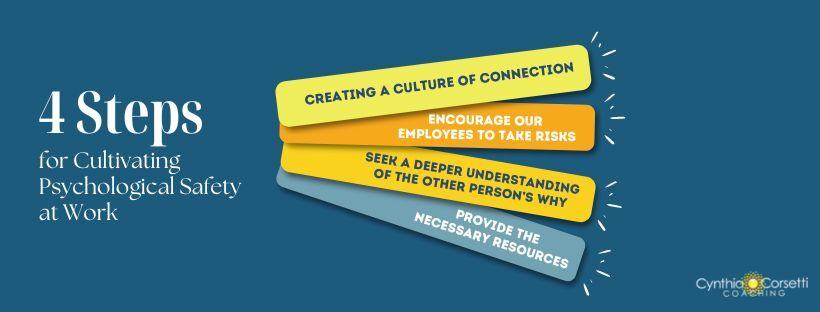Now, more than ever, psychological safety at work is vital for our companies who want to achieve results. It’s also the key to keeping humanity in work— to being more people-focused and to creating an environment that people want to work in, thereby improving retention. But, it’s not as easy as it sounds.
I was listening to the news the other day, and honestly, I had to just turn it off and sit in silence. I took a few deep breaths to find my center. There are so many things happening in our world today. The war in Ukraine, inflation, the possible reversal of Roe vs. Wade, mass shootings, debates on gun control… The list goes on and on. And no matter where you stand on these issues, the news can feel overwhelming.
As I reflected, I realized that leaders in organizations today have a difficult challenge and an increasingly heavy responsibility.
With the state of the world today—including the ongoing threats and aftermath of COVID19, the political divisiveness at every turn, and the dramatic increase in mass shootings—the mental fortitude of our teams is being tested. At this point in time, we live in a world where there is little, if any, psychological safety in our communities. And for that reason, today, more than ever, it is critical for leaders to create environments of psychological safety at work.
Quite simply, when employees don’t feel safe, they become more stressed, experience more anxiety and depression, take more time off, and struggle to perform. Research continues to prove this. Experts continue to validate this. If we want employees to perform, we’d better take psychological safety in the workplace seriously.
The term, psychological safety, was originally coined by Harvard’s Amy Edmondson. She said, “psychological safety means the absence of interpersonal fear.” And plenty of research has illustrated the importance of creating this type of work environment.
For employers, it can feel overwhelming to create an environment that entirely removes interpersonal fear in the workplace. COVID19 reminded all of us that there are things out of our control. One of the lasting effects of the pandemic is the uncomfortable feeling of wondering what might happen next. Then, let’s add in grocery store shootings, school shootings, and while we’re at it, let’s throw in skyrocketing inflation. It’s no wonder employees are showing up for work feeling anxious.
For even the best leaders, the very real need and challenge of creating psychological safety for employees can feel daunting given the state of the world. Especially when there are enormous shareholder responsibilities paired with a need to show bottom-line results, I’ve found that many C-Suite leaders feel like they’re walking a tightrope without a net.
The good news is that while leaders today face a daunting task, they also have an amazing opportunity. Because if they act with vision and intent on building psychological safety within their organization—and to meet those shareholder responsibilities and bottom-line results—they will also be helping their employees become role models for creating psychological safety in the community. And who knows, maybe with enough role models in the world, more good will come.
A recent McKinsey report said 89% of respondents believe psychological safety is essential. So we know psychological safety is critical, then what do we do about it?
Perhaps it makes sense that companies make psychological safety in the workplace a central part of their strategic plan. Because once it becomes an active part of the company strategy, it moves from being an ‘essential soft skill’ to becoming an imperative strategic initiative integrated into every part of the operation. And that is how leaders create a culture of psychological safety.
What does that look like?
While it can take many forms, there are a few that I think can give the biggest bang for the buck…
1. Creating a culture of connection
Employees who work together are often hesitant to connect on a deeper level. But when we teach our employees how to connect in ways that are safe and non-threatening, it begins an open dialogue. Connection activities can become a part of everything we do, whether it’s a few minutes of connection before content at meetings or bringing in a food truck at lunchtime. The more opportunities we provide for our employees to connect on a deeper level, the more they will feel psychologically safe.
2. Encourage our employees to take risks
If employees are called out and humiliated when they make mistakes, they are much less likely to take risks. When our employees are afraid to take risks, we lose in two ways. One, we are creating a toxic work environment ripe for high turnover. In addition, we lose what might be the best solutions or the next greatest opportunity for the organization. All because the employee was afraid to speak up or take a chance. As leaders, we can create an organizational culture where ‘learning and growing’ is respected and rewarded. That’s when we will begin to see a shift. People will be willing to speak because they know they will feel heard.
3. Seek a deeper understanding of the other person’s why
When psychological safety becomes part of a corporate strategy, the organization will provide opportunities for employees to learn the ‘why’ behind a colleague’s point of view—getting to that why requires the skill of asking good questions. When leaders have this skill, they will be more prepared to dig deeper and ask more probing questions to truly understand why the person sees the problem in the way they do. And that’s when the discussion of alternatives becomes valid. Sometimes the alternative is a compromise. What once felt like a loss to one side may now be a solution to both.
4. Provide the necessary resources
A good strategy will include employee benefits with ample resources for mental health. They will factor in self-awareness and emotional intelligence, including meditation and relaxation techniques. A psychologically safe work environment is easier to achieve when individuals have the tools to find their inner peace and the ability to see through their unconscious biases. Attention to mental health should be considered a positive in a safe organization, no stigma attached.
Conclusion.
Teaching employees to connect with others, listen with empathy, communicate with respect, be aware of unconscious bias, and embrace learning as an ongoing process is a value not only to the organization, he is a value to the society at large.
And that’s a good thing for all of us.
—
Learn more about Cynthia’s scope of services and see how she can be the catalyst for change you’ve been looking for— click here.












0 Comments